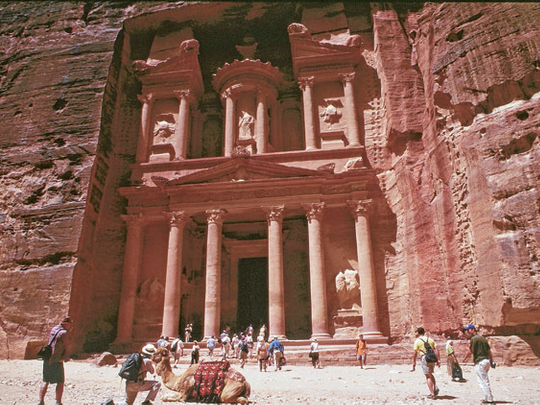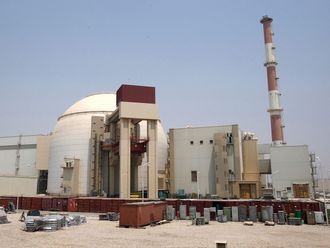
The trip to the site is no picnic for some of us as the gruelling sun mocks us in the merciless heat. But the vigours of the trip are soon forgotten as we see the pink spectacle unfolding before us in the form of the legendary city of Petra, which, centuries ago, was scoffed at by many as "too incredible to have existed".
And, lo and behold, we are there: Petra ("rock" in ancient Greek), the historic and archaeological city in Jordan that has fired the imagination of storytellers and adventurers with its exquisite rock-cut architecture and complex water-conduit system. Indeed, Petra was described as a "rose-red city half as old as time" in a highly acclaimed poem by John William Burgon.
Historians and archaeologists agree that the city was established around the 6th century BC as the capital of the Nabataeans, an ancient tribe that inhabited what is today southern Jordan, Canaan and the northern part of Arabia. Voted in 2007 as one of the "New Seven Wonders of the World" and selected as a Unesco World Heritage Site in 1985, Petra lies on the slope of Mount Hor in a basin among the mountains which form the eastern flank of Arabah, the large valley running from the Dead Sea to the Gulf of Aqaba.
For a long time Petra had remained unknown until it was introduced in 1812 by Swiss explorer Johann Ludwig Burckhardt.
Thanks to its location between the Red Sea and the Dead Sea, the Caravan City, as Petra was sometimes called because the caravan trade plied through it, became an important intersection between Arabia, Egypt and Syria-Phoenecia.
The city is half-built, half-carved into the rocky mountains with an intricate labyrinth of passages and gorges. It is one of the world's famous archaeological sites where ancient Eastern traditions blend with Hellenistic architecture.
The city lies concealed in the surrounding mountains, containing tombs ranging from simple caves to elaborate royal burial chambers. Multicoloured minerals blend magically with the sandstone and change hues as the advancing sun heats the rocks.
Water was a vital tool in the hands of the Nabataeans, who used it to expand their influence and create an artificial oasis in the desert city. Archaeological findings suggest that the Nabataeans could control even the flash floods that afflicted the city; indeed, the Nabataeans had built dams, cisterns and a complex system of water conduits to control the floods. The Nabataeans' ability to store water for judicious use during droughts was a key factor in the city's success and prosperity.
There is evidence that the settlements in and around Petra began in the 18th dynasty of Egypt; this is also listed in Egyptian campaign accounts. However, Petra also came under Roman influence and control in AD106; indeed, even after its native dynasty ended, the city flourished under Roman rule.
However, Petra's fortunes subsequently declined, largely because of the change in the sea-based trade routes. In 363 an earthquake destroyed many of the buildings and crippled the life-giving water-management systems. Later, as the structures became weak with age, many of the tombs inside the city were robbed by thieves.
T.E. Lawrence, better known as Lawrence of Arabia, who was fascinated by Petra's charm, led a force of Arab and Syrian rebels to defend Petra against a much larger combined Turkish-German force.
However, the Petra site today faces challenges, including the collapse of ancient structures, erosion caused by flooding and improper rainwater drainage, weathering from salt upwelling, improper restoration of ancient structures and unsustainable tourism. Tourism boomed in 2007, particularly after the site received extensive media coverage during the "New Seven Wonders of the World" campaign.
A fascinating attraction at the Petra site is a hidden monastery — with more than 900 steps — in the mountains. The faint-hearted tourist can rent a mule for a few dinars for the upward journey. Though Petra does not command the international fame of Egypt's pyramids and the Sphinx, it is gradually moving out of the shadows.
A drive by car from Amman, Jordan's capital, to Petra takes up to three and a half hours. Bus tours, private taxis and private drivers are available. Most of Petra can be seen in a full day but for the studious explorer, a two- or three-day stay can give that satisfying "I have missed nothing" experience.
"Petra is almost always an instant hit with foreign tourists visiting Jordan," said Luma Al Khateeb, the area marketing manager of the Jordan Tourism Board (JTB), in an interview with Weekend Review at the recent International Tourism Bourse of Berlin, where Jordan was showcasing its tourist attractions. Though the Arab Spring affected tourism, Jordanians are confident that the temporary decline will be more than offset in the future.
According to Al Khateeb, Jordan receives the largest tourism traffic from neighbouring Arab countries, though traffic from North America and Europe also increased in 2010. In 2010, Jordan received some 4.5 million foreign tourists, up from 3.78 million in 2009. "Petra and other attractions of biblical interest, such as the River Jordan, where Christ was baptised, and landmarks representing the Old and New Testaments have a strong pull for Western tourists," Al Khateeb explained.
Jordan, which has a capacity of 23,000 hotel rooms, derives roughly 14 per cent of its GDP from what is described as "niche tourism", as opposed to mass tourism.
Petra, which has been featured in many Hollywood films, including Indiana Jones and the Last Crusade and Sinbad and the Eye of the Tiger, is, meanwhile, also courting Bollywood filmmakers.
"Petra, for example, would provide an imposing backdrop setting for Bollywood films," Al Khateeb said. Petra, she added, would also be an added attraction for those participating in MICE (meetings, incentives, conventions and exhibitions) events in Jordan.
Manik Mehta is a commentator on Asian affairs.












